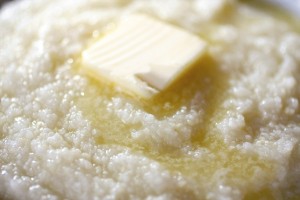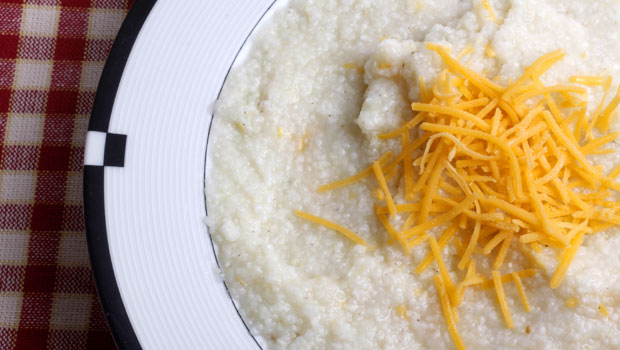Grits: Cuisine of the South

My wife, Maria, just loooves grits. Normally this wouldn't be such a revolution, but she's a born and bred Italian New Yorker. And, New Yorker's do not eat grits. They eat farina, that creamy, smooth, rather bland breakfast portage known by many of us as cream of wheat. My wife Maria was certainly no exception.
About three months into our relationship Maria and I decided to take a long weekend trip to the lower Ozarks in Arkansas, where we stayed at a lodge overlooking the White River. On our last morning while passing through a small village on the way home, we decided to stop for breakfast. As we browsed the menu, Maria disclosed that although she had heard about grits, she had never had them and was curious about their taste. So after some cajoling from me, she decided there would never be a better place to try them than at this tiny country restaurant. From that day on, she has developed an ever growing love for grits, unmatched by any born and bred Southerner that I know.
"Official State Food"
In the year 2002 Georgia made grits their state's official prepared food. South Carolina's Congress had passed a similar bill some 26 years prior, declaring:
"Whereas, throughout its history, the South has relished its grits, making them a symbol of its diet, its customs, its humor, and its hospitality, and whereas, every community in the State of South Carolina used to be the site of a grist mill and every local economy in the State used to be dependent on its product; and whereas, grits has been a part of the life of every South Carolinian of whatever race, background, gender, and income; and whereas, grits could very well play a vital role in the future of not only this State, but also the world, if as The Charleston News and Courier proclaimed in 1952: 'An inexpensive, simple, and thoroughly digestible food, [grits] should be made popular throughout the world. Given enough of it, the inhabitants of planet Earth would have nothing to fight about. A man full of [grits] is a man of peace.' "
So, exactly what are grits?
Grits are a thick, corn-based porridge of Native American origin, commonly served as a breakfast side dish in the American South. The word is derived from the Old English word "grytt," meaning coarse meal. There are basically two schools of thought when it comes to grits--modern hominy grits and old fashioned corn grits.
Hominy grits are ground from hominy, one of the truly American foods, introduced to Sir Walter Raleigh and his men in 1584 by the Native Americans. Hominy is made from the kernels of dent corn (also referred to as field corn) that has been allowed to dry on the cob. It is then picked, cleaned, and soaked in an alkaline solution, causing the kernel's skin to burst and the grain to expand to about twice its original size. The hominy is then dried, coarsely ground, and sifted to produce grits.
Hominy grits, also marketed as "quick grits" and "instant grits," are available in U.S. supermarkets under various brand names. These grits are designed for fast cooking, typically five to seven minutes or less. Although hominy itself is available in both white and yellow varieties, depending on the color of corn used, hominy grits seem to come only in white.
However, a true lover of grits would never consider anything but long cooking, stone-ground corn grits. Unlike hominy grits which can have a rather bland, watery taste, corn grits (requiring 20 to 45 minutes to cook) provide the full corn flavor and creamy texture sought after by grit aficionados.
Corn grits begin with corn that has been dried to an average moisture content of about 17 percent. The kernels are first cleaned and screened to eliminate pieces of stalk, cob, dirt, seeds, burs and other field debris that may be mixed with the corn. The cleaned  corn is then fed into the grinder where granite millstones weighing up to 1,500 pounds each are used to grind the dry kernels into a mixture of grits, meal, and cracked corn before being dropped into the sifter where it is separated. The first to be sifted is cornmeal, followed by grits, leaving only the cracked corn which is then recycled through the grinding operation to obtain more meal and grits. Typically the final yield per hundred pounds breaks down to 50 percent corn meal, 40 percent grits, and the rest a light bran used in producing a wide variety of products.
corn is then fed into the grinder where granite millstones weighing up to 1,500 pounds each are used to grind the dry kernels into a mixture of grits, meal, and cracked corn before being dropped into the sifter where it is separated. The first to be sifted is cornmeal, followed by grits, leaving only the cracked corn which is then recycled through the grinding operation to obtain more meal and grits. Typically the final yield per hundred pounds breaks down to 50 percent corn meal, 40 percent grits, and the rest a light bran used in producing a wide variety of products.
Historically white were the grits of choice in urban port cities of the south, while yellow corn grits were more predominant in the inland rural areas. Today, it is thought that white corn varieties have more mineral and floral nuances than the yellow varieties. Although available throughout the U.S., three-quarters of all grits are sold in the "grits belt," an area below the Mason-Dixon line from Virginia to Texas.
 In the past, grits may have been considered by most as a side dish to be served alongside your morning eggs, but their popularity has grown in recent years as chefs throughout America rediscover heirloom foods and reinvent regional dishes of the past.
In the past, grits may have been considered by most as a side dish to be served alongside your morning eggs, but their popularity has grown in recent years as chefs throughout America rediscover heirloom foods and reinvent regional dishes of the past.
I hope that after reading this story you will give grits a try and grow to enjoy them, just as Maria did. They are one the great foods of the American South.
Buy Em: Adluh Stone Ground Corn Grits, Antebellum Coarse Grits, Palmetto Farms White Corn Stone Ground Grits
Make Em: Shrimp & Grits, Charleston-Style Grits, Smoked Gouda Cheese Grits


